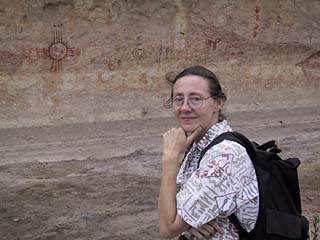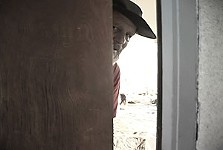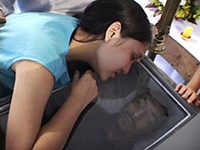History Repeats
A writer and his artist aunt explore cave paintings and see more than just writing on the wall
By Eli Kooris, Fri., Aug. 17, 2001

Judy Miller is sitting on a couch near the back of the gallery; she looks forlorn. Tragedy has struck in recent days -- a close family friend was killed in a car accident just outside of town. Her husband and owner of the gallery, Charles, was a pallbearer in the funeral the day before, and they are still wading through the grief.
"These things just happen when you least expect it," Judy says, veiling her sorrow with a bubbling of words. "It's God's plan, not ours. Like why we own a business here -- this is just where my husband and I ended up."
It is midmorning at the Charles Miller Custom Knives & Gallery in Burnet, a community of just over 3,000, known more for its deer hunting than its art scene. Yet just a block outside of the historic square on South Main street lies one of Texas' most reputable vendors of handmade knives and Southwestern art -- think Santa Fe: paintings, sculptures, and jewelry that mirror the Southwest U.S. as it was some centuries ago. While the gallery boasts a few colorful portraits of cowboys living on the range typical of the area, the Native American influence abounds, through the jewelry, the sculptures, the general earthy feel and look of everything. One piece in particular stands out, a small, flat stone with a re-created cave drawing by M.D. Davis, who is 20 minutes late for our scheduled departure time. M.D. Davis is my aunt and is driving down from Dallas to meet me, so truancy is to be expected. Besides offering an intimate look at how she re-creates Native American pictographs, Davis will be leading me down to the lower Pecos River in South Texas to view genuine cave paintings at Meyers Springs that have been opened to a select few for the first time since the 1920s.
"There is a lot of spirituality here," gallery owner Miller interjects about her space, and it takes me a moment to realize she is talking about the artwork. "These people lived simple lives, but they had an understanding of the world, much deeper than most people think."
The dim interior of the gallery is momentarily awash in morning sunlight; the screen door slams, and I turn to find my aunt standing in the entrance, adorned in her classic outdoors attire: hiking boots and pants, a button-down Indian print short sleeve shirt, and backpack under pigtails of long brown hair, two small turquoise clips holding them together. Memories return in a blinding wave. She wore that same outfit years before, whenever she and my uncle would take me to the rivers around our family ranch in Oklahoma. There we would spend afternoons bass and gar fishing in the deep green water, watching for snakes and snapping turtles, pushing along the banks lined thick with foliage and massive, felled tree trunks covered in a carpet of green. I remember once my aunt blew apart a water moccasin with two rifle blasts as she was poised on the bank 6 feet above the creature, when it swam too close to our stringer of bass. Both shots were jaw-dropping in accuracy, providing the best fish dinner I have ever had. The next morning I found my hands itchy and swollen with poison ivy. Being involved with nature, almost giving yourself to it, was a recurring theme when spending time with my mother's youngest sister.
M.D. (what it stands for is a family secret, part of the intended mystique surrounding her work) Davis has been re-creating cave paintings for less than a decade, and her art is already being sold all over the world, from Japan to Germany. She goes to sites all over the nation -- the best, according to her, are in Southwest Texas -- and photographs Native American artwork, their canvases of rock, the outcroppings of cliff faces or walls of caves left by the dried-up tributaries of rivers. From there, she uses the photographs as a blueprint and copies the paintings image for image, color for color, onto pieces of hand-picked stone, binding the paint with linseed oil and blood. Among fans and even close relatives, there are lingering questions as to why she didn't start her artwork earlier in life.
"It was fear, mainly ... " my aunt says, looking out at the horizon, as we speed down Highway 29 at over 80 mph, admiring the subtle transition between the landscapes of Central and South Texas. A sea of yellow coreopsis washes against the banks of the road, speckled with intense dots of red Indian Paintbrushes. Evidently, late May is a migration time for both butterflies and grasshoppers, and they splatter on the windshield like the victims of some macabre Jackson Pollock painting. " ... fear that if I showed these, shall we say, 'unprotected artistic works' to the public, they may be destroyed, and I would feel responsible," she continues and then smiles. "And then of course, there is every artist's fear of people not accepting your work."
Distant memories linger of the first time my aunt ever saw a cave painting: on a cross-country motor home trip with my mother and grandparents when she was five. She remembers standing small at the foot of a cliff face, in awe of what was in front of her, that people from centuries before were sharing a part of their lives. From that moment on, Davis knew her passion would center on Native American art.
Yet life suddenly stepped in her way. My aunt has dyslexia, and it was never properly treated during her upbringing in the late Sixties, the tail end of a generation stricken with self-denial about any psychological ailments. She ended up at Tyler Junior College, where she met my uncle Wayne, a Vietnam veteran (and one of the most amazing men I know) riddled with physical and emotional scars and a handful of chemical dependency issues. Together they loved art, they loved nature, they loved history, and most importantly, they loved each other through rear-end collisions, dying dogs, and jail time. Soon enough, they were married. They set up a furniture restoration company near their home in Lewisville, nursing artifacts of the past back to life by retrofitting with new parts, transfusing finishes, and opening up guts and rewiring. But money was short, and bills had to be paid: Reality of life overshadowed any passion or dream.
"Day-in, day-out living became monotonous, and I had to take a chance and follow my passions," Davis says. "Something was pushing from within, more important than any of my emotions, more important than money. It finally got to the point where I had no choice."
The idea of how to express her passion manifested itself slowly, starting 10 years ago. She painted a couple of T-shirts in pictograph form using acrylic paint, passing them along to nephews and other relatives on their birthdays, and someone bought one off her back in a Dallas supermarket. Her skill was suddenly marketable, as was the artistic message.
"I came to find that others shared the same awestruck feeling from the image I did," my aunt says. We are on Highway 90 now, crossing the Devil's River and heading west, tracing along the border of Mexico. The land has turned bitter and burnt, daunting in scope and emptiness. "I felt like I needed to find more of those people who shared that feeling."

She found them through the Rock Art Foundation, which promotes public education, research, and preservation of pictographs in Texas. The nonprofit organization based out of San Antonio was set up in 1991 by Jim Zintgraff, a commercial photographer who found the White Shaman pictographs while following state archeologists through a small canyon off the Lower Pecos in 1956. During the next four decades, he has photographed nearly 300 sites and has seen his organization grow from six members to 900 in just 10 years.
"These people say something about culture," Zintgraff says and takes a light pull on his cigar. We are sipping beer on picnic tables at the Galloway White Shaman Preserve, the main campgrounds of the Rock Art Foundation nestled between the border towns of Comstock and hanging Judge Roy Bean's Langtry. Zintgraff's young and passionate manner -- as intense as that of any of the other travelers present this weekend -- belies his 70 or so years. "By our standards they were primitive, but their culture survived almost 10,000 years, longer than the Roman, Egyptian, and our own culture combined. If we could mirror their actions, maybe we could last as long. All we have to go by, however, are the pictures they left on walls."
We spend the rest of the afternoon over beer and MREs (Meals Ready to Eat) and meet the arriving travelers over bites of canned pineapple and sweet, soggy spaghetti. There is Dean Mitchell, a stonemason; Julie Beaver, an elementary school teacher; Jim Seavers, an insurance broker from New Braunfels who also came with a relative, his uncle, a portrait artist. Jack and Jane McDonald from Pleasanton are hopelessly in love and make the best grilled pork chops after a long day of hiking. Exhausted, I turn in just past sunset, crawling into my pup tent under a snow globe of stars. It is a restless sleep, between the dive bombings from mosquitoes and gnats and the dull slap of the hard desert wind that whips against the tent's nylon walls. I have been a city boy too long.
My aunt is up before everyone the next morning, excited, pacing, ready to go. It is an hour drive west to the property and another hour or so down trenchridden dirt roads that wind through the brush and flatland. Gray clouds hang low, thunder rumbles above us and about the time our 10-car caravan hits the property, rain lets loose.
"Imagine having to live in the desert," Davis says. "Beautiful yet very hard. Another reason why these paintings are so amazing, that through all of the survival necessary in this land, these people still had time to be creative. They still had time to make art."
We drive for more than an hour through ranch land, a slow pace over sharp rocks stabbing out of the road. Passengers in a couple of smaller cars, fearful of loosing an oil pan, are forced to pull over and hitch a ride with the trucks and sports utility vehicles. When we finally arrive, the clouds break and the midday sun wrestles through. Davis jumps ahead of the pack as we make the short hike down the wide dirt path to Meyers Springs. The site was owned by one family since the 1920s, and they knew what sort of historical significance their land held. So they protected it, keeping the public at bay. Only now, more than 70 years later, will the land be sold to the Rock Art Foundation to ensure the paintings' safety.
Meyers Springs was tapped as a resource by John Boulis, a post-Civil War officer who led the famous Buffalo Soldiers in campaigns against the Apaches and Comanches during the late 1800s. A stone wall built by his men still stands, collecting water from the springs. Just to the left however, is the real mark of history -- a mural of pictographs stretching along nearly 200 feet of sheltered limestone. The group responds with oohs and ahhhs of awe as we approach; my aunt stands silently just a few feet away, on the verge of tears.
"Analyze these like you would any other piece of art," Davis says to me, her voice hushed, like we are in a museum. "Certain things are intentional, images are rudimental but deep with meaning. It comes down to the observer, as usual."
Every painting at Meyers Springs seems to have its own message, yet it is hard to see where one ends and another begins. Go under a bridge in any large city, and you'll get an idea of what I am talking about. While spray paint may have replaced red ochre through centuries of technology, the stories told by the artists are almost identical. In fact, soldiers and pioneers wandering through the area a century before have left their own marks, names, and dates of their presence on the wall, something the Rock Foundation members scoff at. Some marks are considered graffiti while others are considered art.
Regardless, all of these are people trying to make their mark, share their lives, their experiences with a world that would otherwise never know they existed. The paintings are a window, a time portal, showing how the natives hunted, groups of animated men with spears chasing boxy buffalo, and what they worshipped, the symmetrical sun, the Apache thunderbird, and the repeated omnipresent icon of a shaman. There are handprints left on the walls, perhaps their most striking statement of individuality.
"It also shows their mythology to a certain extent," Zintgraff says as we examine the paintings. "Like the Sistine Chapel shows Christian mythology, how that group recorded history. This is the Native American's way of doing the same thing."
Interpretations of history can be drawn from the cave paintings. One painting appears to be an aerial view of a ship with masts and flags, crosses jutting out of it on all sides. Spaniards landed in Mexico centuries before and forged north through Texas, determined in their missionary work. One picture. A thousand words ...
We stayed at Meyers Springs for a few more hours, snapping countless photographs, corralling a rock rattler, and eating lunch. "Things seem to stop when I look at those paintings, like I'm peering back in time," Davis tells me on our long trip back through the desert. She is more than satisfied with what she has seen, and her seven rolls of film will prove it, laying the groundwork for many future projects.
"The thing that amazes me the most about all of these paintings is that the paintbrushes were so small and some of the images are so large and complex. It must have taken hours, days of their time, when they had so many responsibilities. That's dedication, that's love, that's passion for one's art." Davis pauses, thinking for a moment as the desert blurs by her window.
"Maybe we haven't changed all that much." ![]()








